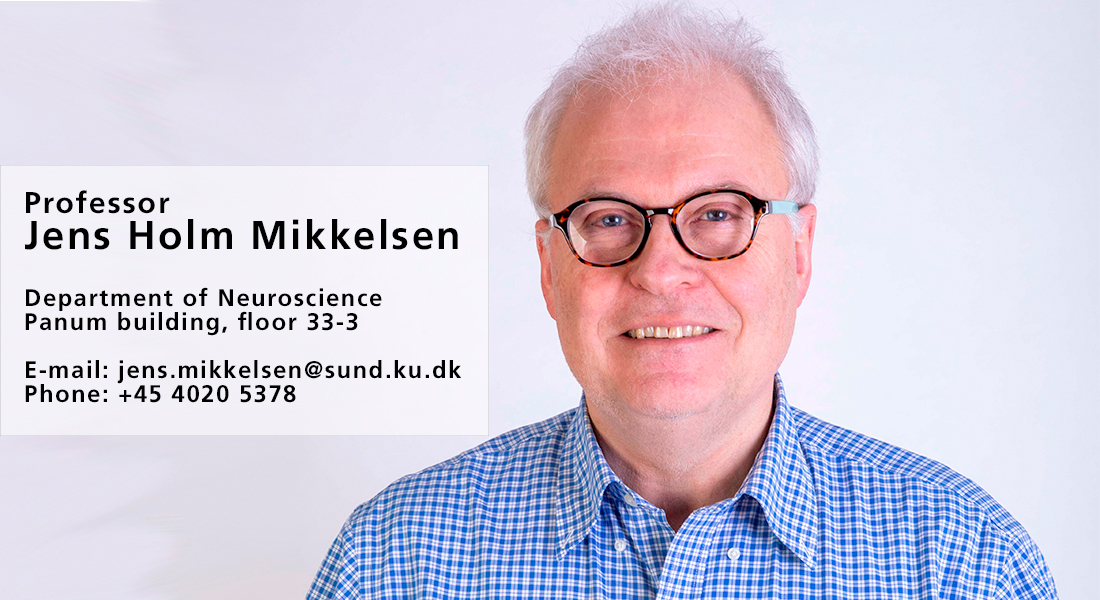Mikkelsen Lab
We are interested in synaptic plasticity and neuroinflammation. We develop novel methods to measure these processes in the human brain and in animal models. We do this to study brain pathology and drug action and these affect these changes in the brain. Below is a more detailed description of the research projects that we are currently working on.

Professor Mikkelsen is also Principal investigator at the Neurobiology Research Unit at the Neurology Center, at the University Hospital, Rigshospitalet, and conducts research at the hospital. See links:
Project 1. Determination of synaptic plasticity in health and disease
Formation and loss of synapses is defined as synaptic plasticity. Formation of new functional synapses or synaptogenesis is likely an ongoing process in the human brain, and may be either inhibited or enhanced in brain disease. Monitorization of the progression of the synaptic changes in patients in vivo has not been technical feasible until now. However, UCB-J and other radioligands that bind to the (pre)synaptic vesicle glycoprotein 2A (SV2A) and imaging have been promising, and my laboratory is now interested to determine to what extent this method indeed measures synaptic density and functional synapses in health and disease.
In human temporal cortical resections ex vivo obtained from patients with temporal lobe epilepsy, we have shown that SV2A is expressed in all cortical neuronal subtypes, and that expression of SV2A mRNA and binding levels are lower in epilepsy brains compared to matched post-mortem controls without neurological disease (Pazarlar et al., Mol Brain 2022). We have also compared these observations directly to spatial and temporal changes in SV2A binding in three models of epilepsy in rats (Mikkelsen et al., Neuroscience 2022; Pazarlar et al., Epilepsy Research, 2022), and found that [3H]-UCB-J radioligand binding decreases in the latent phase in the models while the level rises in the chronic phase, demonstrating epileptogenesis.
Project 2. Synaptic plasticity in Alzheimer’s disease, major depression and stroke.
Changes in synapses are believed to occur in a number of CNS disorders. Markers of synapses have been used to indicate loss of synapses, but not to demonstrate synaptogenesis. With the introduction of SV2A imaging, we are in a position to better measure synaptic density, and synaptogenesis. With this we determine the level of synapses in neurological and psychiatric disorders and whether pharmacological treatments have positive effect via plastic changes of the brain.
Project 3. Neuroinflammation in disease
Neuroinflammation or activated microglia (the innate immune cells of the CNS) can be induced and chronic inflammation causes the degradation of tissue. Using radiotracers that bind to targets expressed in microglia cells, we can not only identify neuroinflammation, but also study various mechanisms. These targets include translocator protein (TSPO) and purinergic 2X7 receptor (P2X7) (Mikkelsen et al, ACS Neurosci, 2023) as well as others that are under validation.
Project 4. Epileptogenesis
Epileptogenesis is a dynamic process in which alterations in morphology and pathophysiology of the neuronal network and supporting cells where the neuronal excitability in these networks eventually become high enough to generate unprovoked repetitive seizures. As epileptogenesis develops over time starting in the latent phase, the change in the neuronal circuit leads to hyperexcitation in the epileptic focus and spreads to other areas of the temporal lobe and beyond. We conduct studies in animal models to understand and perhaps prevent such changes under the progression from the early cause or insult to the latent phase where it develops into chronic epilepsy where the damage may be more difficult to treat.
...
...
Lab members
| Name | Title | Job responsibilities | Image |
|---|---|---|---|
| Search in Name | Search in Title | Search in Job responsibilities | |
| Burcu Azak Pazarlar | Postdoc | Mikkelsen Lab |
|
| Jens Holm Mikkelsen | Professor | Mikkelsen Lab |
|
| Qi Wang | PhD Student | Mikkelsen Lab |
|
